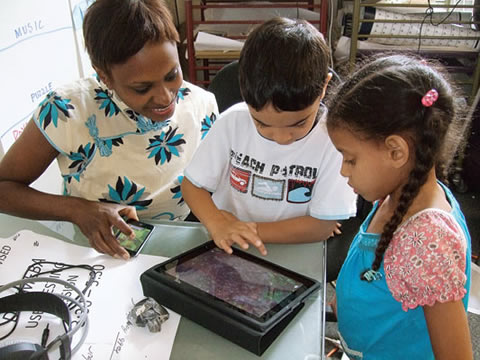Handheld touch-screen devices such as iPads may offer a window into the previously incommunicado world of children with severe developmental challenges.
At Beverley Public School, a K-8 school for 89 special-needs kids in the heart of downtown Toronto, teachers and researchers were thrilled to see that touch-screen technology instantly engaged children in ways that laminated pictures and verbal instructions had not. The two-year study, which ended last December, found that within six weeks the devices boosted kids’ attention spans, raised their ability to identify pictured objects by 45 to 60 per cent, and improved communication skills in these mostly nonverbal children by 20 per cent.
A surprising bonus: students who had never been sociable were suddenly requesting an iPad to initiate an activity with another student. “We were shocked by that,” says lead researcher Rhonda McEwen, a professor at the Institute of Communication, Culture and Information Technology at U of T Mississauga, and the mother of a nonverbal eight-year-old daughter with autism spectrum disorder (ASD).
McEwen suggests that the devices’ appeal may lie in their multisensory nature, with images and sound – and vibration (thanks to the addition of a downloadable app). She adds that the device’s voice app, which is always calm and unemotional, appeals to those who thrive on consistency, including many children with ASD. One boy in kindergarten who had always ignored green “yes” and red “no” boxes on paper responded instantly to the identical boxes on the screen. Kindergarten teacher Stacie Carroll, who sourced a number of apps to record kids’ responses for the study, says, “We discovered that many children had an understanding of vocabulary that didn’t just exceed what we thought but blew it out of the water.”
The study began with iPod Touches, then added iPads as soon as they became available in Canada. The iPad’s larger screen is better suited to children with vision or fine-motor challenges, such as the blind six-year-old in a wheelchair who delights in moving his arm across the tablet to create his own music. The school now also owns two iPad 2s with cameras, which allow teachers to email students’ artwork instantly to parents.
“These kids, who are often marginalized in our school system, now have a profile,” says principal Alana Grossman. “The devices have given teachers a sense of excitement, and parents a sense of hope and pride.”
McEwen is now studying the devices in middle and high schools.
Recent Posts
U of T’s Feminist Sports Club Is Here to Bend the Rules
The group invites non-athletes to try their hand at games like dodgeball and basketball in a fun – and distinctly supportive – atmosphere
From Mental Health Studies to Michelin Guide
U of T Scarborough alum Ambica Jain’s unexpected path to restaurant success
A Blueprint for Global Prosperity
Researchers across U of T are banding together to help the United Nations meet its 17 sustainable development goals







One Response to “ An Apple for the Students ”
I am a middle school ASD teacher with the TDSB, I am wondering how I can get more information about I might be able to participate in the the IPAD pilot project? Any information you have would be much appreciated!